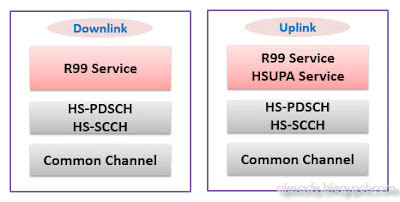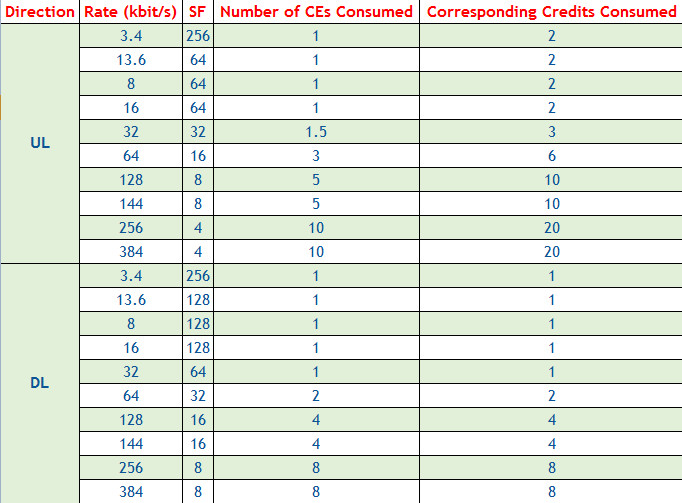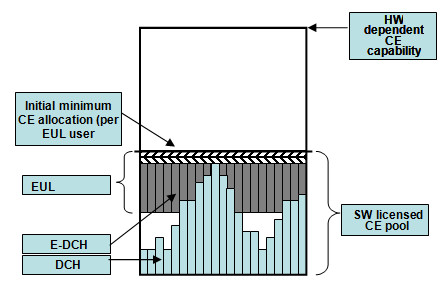Channel Element
The SW licensed capacity resources required for a dedicated channel (DCH or E-DCH) are described by Channel Element (CE). The number of channel elements required in a RBS is based on the traffic type and is dependent on the radio bearers to be used and on the simultaneous users for each bearer.
Hardware
Channel elements will be consumed in UL and DL every time a dedicated channel is allocated. Depending on the type of radio bearer for the dedicated channel, the consumption can be described as a cost. Through weighting factors for the various radio bearers, the channel element cost can be estimated.
Blocking may happen if there is not sufficient amount of channel elements available. User will be switched down to a lower rate to avoid blocking and to make channel elements available for the requested dedicated channel.
Channel Element (CE) Resource
CE resource is a type of NodeB hardware resource. The number of CEs supported by single NodeB indicates the channel demodulation capabilities resource of the NodeB. The more CEs a NodeB supports, the more powerful the channel demodulation and service processing capabilities for serving the customers. To ensure sufficient channel demodulation, services at different rates require different numbers of CEs.
CE resources are managed by both the RNC and NodeB in a RAN where CE capacity is reported by the NodeB to the RNC. The RNC determines whether to admit a new service based on the number of CEs that need to be consumed and controls CE resources during CE congestion. This ensures the proper use of CE resources. The NodeB dynamically manages CE resources and rapidly adjusts the number of CEs that can be consumed based on the actual service rate. This increases CE resource usage.
Basic Channel Element Concepts
the channel demodulation capabilities of a NodeB are measured by CE unit. CEs are classified into uplink (UL) CEs and downlink (DL) CEs.
- One UL CE needs to be consumed by a UL 12.2 kbit/s voice service (SF = 64) plus 3.4 kbit/s signaling.
- One DL CE needs to be consumed by a DL 12.2 kbit/s voice service (SF = 128) plus 3.4 kbit/s signaling.
One CE still needs to be consumed if 3.4 kbit/s signaling traffic is carried on a DCH or HSPA channel. The number of CEs that need to be consumed by services of other types can be calculated by analogy.
The number of UL and DL CEs supported by a NodeB is determined by the NodeB hardware capabilities and the licensed CE capacity. The number of UL and DL CEs supported by the NodeB hardware is called the physical CE capacity. The physical CE capacity may differ from the licensed CE capacity. The smaller determines the number of CEs that can be used by an operator.
CE is a concept of the NodeB side. On the RNC side, it is called NodeB credit. Based on the NodeB credit, the RNC performs admission and congestion control. The number of Node credit resources in the UL is twice that of CEs while the number of NodeB credit resources in the DL equals that of CEs.
Rules for Calculating CE Consumption
Based on the SF that matches the service rate, the RNC determines the number of CEs required for a service. When an RAB connection is set up for a service, CE resources must be assigned or taken back and the number of CEs must be decreased or added accordingly. Channels or services of different types have different rules for calculating CE resource consumption.
- In gray, CE resources reserved by the NodeB for common and HSDPA channels.
- In pink, CE resources that need to be consumed by R99 and HSUPA services.
Common Channels CE Consumption
the NodeB reserve CE resources required on the UL and DL common channels; therefore, they do not occupy the licensed CE capacity. These CEs do not need to be considered in the calculation of CE consumption.
HSDPA Channels CE Consumption
Similarly, the NodeB reserves CE resources for the high-speed downlink shared channel (HS-DSCH) and the related control channels if HSDPA is used. In the calculation of CE consumption, these CEs do not need to be considered.
It is important to note that the signaling of an HSDPA UE occupies one DCH and needs to consume one DL CE that if not performing an R99 service. The signaling of an HSDPA service does not consume additional CE resources if the SRB over HSDPA function is enabled. For an HSDPA UE, its signaling and the R99 service occupy the same DCH that if it is performing an R99 service. Thus, we only need to calculate the CEs consumed on R99 traffic channels.
channel elements will not be consumed by traffic on the HS-DSCH. Nevertheless, for UL/DL signaling and UL traffic, every HSDPA connection will require A-DCHs. A‑DCHs are dedicated channels, which consume channel elements. Dimensioning of DL resources for A-DCH is not needed since DL A-DCHs do not consume resources from the normal pool of SW licensed channel elements. However, resources for UL A-DCH have to be considered since they consume channel elements from the normal SW licensed pool.
R99 Service CE Consumption
For an R99 service, the RNC determines the number of CEs and NodeB credit resources that need to be consumed based on the SF that matches the maximum bit rate (MBR) of the service.
Enhanced Uplink (EUL)
EUL can only be utilized for connections that have HS-DSCH in the DL. Traffic and signaling on an E-DCH will be carried by each admitted EUL user.
Similar to HSDPA, the E-DCH user has one serving cell. The E-DCH serving cell is always equal to the HS-DSCH serving cell for the connection. There is always at least one non-serving E-DCH cell if the terminal is in soft or softer handover.
From the SW licensed CE pool, E-DCH users consume channel elements. However, compared to A-DCH and DCH, the resources for E-DCH are handled in a different manner.
The resources for E-DCH are controlled by the EUL scheduler located in the RBS and resources for A-DCH and DCH are controlled by the RNC.
a minimum amount of channel elements allocated will be used by each admitted E-DCH user. Depending on licensing, the minimum amount of channel elements will be determined.
Those channel elements are reserved to the E-DCH user as long as the user is active in the cell. For non-scheduled data (signaling) and scheduled data to a certain rate (user data), minimum channel element allocation can be used.
Represented by the minimum CE allocation, the channel elements are secured and are not changed by Enhanced Soft Congestion or re-scheduling in the RBS.
Therefore, reaching a minimum rate supported by the minimum CE allocation is possible for an admitted E-DCH user.
Additional channel elements will be needed if an E-DCH user requests rates higher than the rates supported by the minimum CE allocation.
These are not seen by the Admission Control function and are managed by the EUL scheduler only. If it is achievable to allocate more CEs in addition to the other two required UL resource types (air interface interference and Iub bandwidth), the EUL scheduler will give an E-DCH user a higher rate.
The additional CEs for an E-DCH user might be affected by Enhanced Soft Congestion or re-scheduling in the RBS.
If the minimum amount of channel elements is not available at the E-DCH establishment attempt it will not be possible to admit a new E-DCH user.





